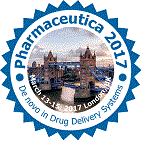
António José Ribeiro
University of Coimbra, Portugal
Title: Nanoprecipitation for delivery of Insulin
Biography
Biography: António José Ribeiro
Abstract
Micro and nanoparticulates made of poly (lactic-co-glycolic acid) (PLGA) have been extensively studied due to their biocompatibility, biodegradability and ability to control release of drugs and have been linked to delivery of proteins. Nanoprecipitation is the most appropriate method to produce nano sizing particles for parenteral delivery without harsh conditions of temperature and agitation, making use of water miscible solvents and involving a simple set up. However, attempts to encapsulate proteins and specially insulin in PLGA nanoparticles using nanoprecipitation have revealed limited success due to a low efficiency of encapsulation /EE). Insulin-PLGA nanoparticles (Ins-PLGA NPs) for parenteral administration were produced by nanoprecipitation without any co-solvent or additive to insulin, buffering the dispersant phase. NPs were freeze-dried with sorbitol and characterized for size and polydispersity (PdI) and zeta potential. Insulin extracted from NPs was assayed using HPLC and its conformation was assessed before, during and after procedure using circular dichroism (CD). In vitro release studies were performed to access insulin release kinetics.
NP's with a mean size lower than 200 nm a low PDI were obtained after freeze-drying and revealed physical stability after reconstitution in water. EE of NP's was greatly improved compared to previous attempts, and among formulations, the choice of a buffer with a pH close to the PI of insulin revealed a higher EE. Insulin secondary conformation was maintained during manufacture so insulin was not markedly degraded during the manufacturing process. Insulin release from NP's showed a high burst effect and a release medium pH behavior. The PLGA based NP's buffered formation occurs under mild conditions and consequently can be used as a platform for delivery of labile molecules such as most of the biotechnology-based drugs.

